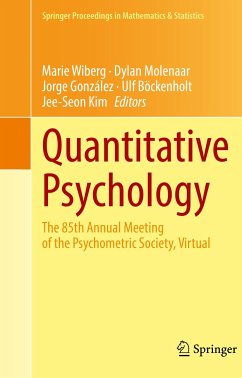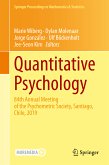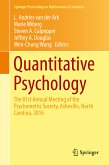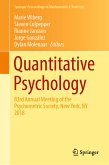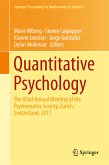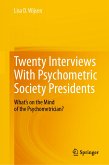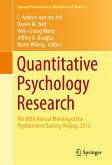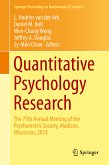Quantitative Psychology (eBook, PDF)
The 85th Annual Meeting of the Psychometric Society, Virtual
Redaktion: Wiberg, Marie; Kim, Jee-Seon; Böckenholt, Ulf; González, Jorge; Molenaar, Dylan


Alle Infos zum eBook verschenken

Quantitative Psychology (eBook, PDF)
The 85th Annual Meeting of the Psychometric Society, Virtual
Redaktion: Wiberg, Marie; Kim, Jee-Seon; Böckenholt, Ulf; González, Jorge; Molenaar, Dylan
- Format: PDF
- Merkliste
- Auf die Merkliste
- Bewerten Bewerten
- Teilen
- Produkt teilen
- Produkterinnerung
- Produkterinnerung

Hier können Sie sich einloggen

Bitte loggen Sie sich zunächst in Ihr Kundenkonto ein oder registrieren Sie sich bei bücher.de, um das eBook-Abo tolino select nutzen zu können.
This proceedings volume highlights the latest research and developments in psychometrics and statistics. It represents selected and peer-reviewed presentations given at the 85th Annual International Meeting of the Psychometric Society (IMPS), held virtually on July 13-17, 2020.
The IMPS is one of the largest international meetings on quantitative measurement in education, psychology and the social sciences. It draws approximately 500 participants from around the world, featuring paper and poster presentations, symposiums, workshops, keynotes, and invited presentations.
Leading experts…mehr
- Geräte: PC
- ohne Kopierschutz
- eBook Hilfe
- Größe: 8.44MB
![Quantitative Psychology (eBook, PDF) Quantitative Psychology (eBook, PDF)]() Quantitative Psychology (eBook, PDF)113,95 €
Quantitative Psychology (eBook, PDF)113,95 €![Quantitative Psychology (eBook, PDF) Quantitative Psychology (eBook, PDF)]() Quantitative Psychology (eBook, PDF)113,95 €
Quantitative Psychology (eBook, PDF)113,95 €![Quantitative Psychology (eBook, PDF) Quantitative Psychology (eBook, PDF)]() Quantitative Psychology (eBook, PDF)113,95 €
Quantitative Psychology (eBook, PDF)113,95 €![Quantitative Psychology (eBook, PDF) Quantitative Psychology (eBook, PDF)]() Quantitative Psychology (eBook, PDF)81,95 €
Quantitative Psychology (eBook, PDF)81,95 €![Twenty Interviews With Psychometric Society Presidents (eBook, PDF) Twenty Interviews With Psychometric Society Presidents (eBook, PDF)]() Lisa D. WijsenTwenty Interviews With Psychometric Society Presidents (eBook, PDF)105,95 €
Lisa D. WijsenTwenty Interviews With Psychometric Society Presidents (eBook, PDF)105,95 €![Quantitative Psychology Research (eBook, PDF) Quantitative Psychology Research (eBook, PDF)]() Quantitative Psychology Research (eBook, PDF)89,95 €
Quantitative Psychology Research (eBook, PDF)89,95 €![Quantitative Psychology Research (eBook, PDF) Quantitative Psychology Research (eBook, PDF)]() Quantitative Psychology Research (eBook, PDF)113,95 €
Quantitative Psychology Research (eBook, PDF)113,95 €-
-
-
The IMPS is one of the largest international meetings on quantitative measurement in education, psychology and the social sciences. It draws approximately 500 participants from around the world, featuring paper and poster presentations, symposiums, workshops, keynotes, and invited presentations.
Leading experts and promising young researchers have written the included chapters. The chapters address a wide variety of topics including but not limited to item response theory, adaptive testing, Bayesian estimation, propensity scores, and cognitive diagnostic models. This volume is the 9th in a series of recent works to cover research presented at the IMPS.
Dieser Download kann aus rechtlichen Gründen nur mit Rechnungsadresse in A, B, BG, CY, CZ, D, DK, EW, E, FIN, F, GR, HR, H, IRL, I, LT, L, LR, M, NL, PL, P, R, S, SLO, SK ausgeliefert werden.
- Produktdetails
- Verlag: Springer International Publishing
- Seitenzahl: 497
- Erscheinungstermin: 22. Juli 2021
- Englisch
- ISBN-13: 9783030747725
- Artikelnr.: 62287459
- Verlag: Springer International Publishing
- Seitenzahl: 497
- Erscheinungstermin: 22. Juli 2021
- Englisch
- ISBN-13: 9783030747725
- Artikelnr.: 62287459
- Herstellerkennzeichnung Die Herstellerinformationen sind derzeit nicht verfügbar.
